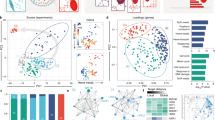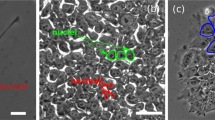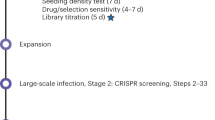Abstract
During the development of an organism, cells are exposed to a myriad of signals, structural components and scaffolds, which collectively make up the cellular microenvironment. The majority of current developmental biology studies examine the effect of individual or small subsets of molecules and parameters on cellular behavior, and they consequently fail to explore the complexity of factors to which cells are exposed. Here we describe a technology, referred to as arrayed cellular microenvironments (ACMEs), that allows for a high-throughput examination of the effects of multiple extracellular components in a combinatorial manner on any cell type of interest. We will specifically focus on the application of this technology to human pluripotent stem cells (hPSCs), a population of cells with tremendous therapeutic potential, and one for which growth and differentiation conditions are poorly characterized and far from defined and optimized. A standard ACME screen uses the technologies previously applied to the manufacture and analysis of DNA microarrays, requires standard cell-culture facilities and can be performed from beginning to end within 5–10 days.
This is a preview of subscription content, access via your institution
Access options
Subscribe to this journal
Receive 12 print issues and online access
$259.00 per year
only $21.58 per issue
Buy this article
- Purchase on Springer Link
- Instant access to full article PDF
Prices may be subject to local taxes which are calculated during checkout





Similar content being viewed by others
References
Chen, Y., Yu, P., Luo, J. & Jiang, Y. Secreted protein prediction system combining CJ-SPHMM, TMHMM, and PSORT. Mamm. Genome 14, 859–865 (2003).
Grimmond, S.M. et al. The mouse secretome: functional classification of the proteins secreted into the extracellular environment. Genome Res. 13, 1350–1359 (2003).
Brafman, D.A., Shah, K.D., Fellner, T., Chien, S. & Willert, K. Defining long-term maintenance conditions of human embryonic stem cells with arrayed cellular microenvironment technology. Stem Cells Dev. 18, 1141–1154 (2009).
Brafman, D.A. et al. Investigating the role of the extracellular environment in modulating hepatic stellate cell biology with arrayed combinatorial microenvironments. Integr. Biol. (Camb) 1, 513–524 (2009).
Flaim, C.J., Chien, S. & Bhatia, S.N. An extracellular matrix microarray for probing cellular differentiation. Nat. Methods 2, 119–125 (2005).
Flaim, C.J., Teng, D., Chien, S. & Bhatia, S.N. Combinatorial signaling microenvironments for studying stem cell fate. Stem Cells Dev. 17, 29–39 (2008).
Soen, Y., Mori, A., Palmer, T.D. & Brown, P.O. Exploring the regulation of human neural precursor cell differentiation using arrays of signaling microenvironments. Mol. Syst. Biol. 2, 37 (2006).
La Barge, M.A. et al. Human mammary progenitor cell fate decisions are products of interactions with combinatorial microenvironments. Integr. Biol. (Camb) 1, 70–79 (2009).
Brafman, D.A. et al. Long-term human pluripotent stem cell self-renewal on synthetic polymer surfaces. Biomaterials 31, 9135–9144 (2010).
Anderson, D.G., Putnam, D., Lavik, E.B., Mahmood, T.A. & Langer, R. Biomaterial microarrays: rapid, microscale screening of polymer-cell interaction. Biomaterials 26, 4892–4897 (2005).
Damoiseaux, R., Sherman, S.P., Alva, J.A., Peterson, C. & Pyle, A.D. Integrated chemical genomics reveals modifiers of survival in human embryonic stem cells. Stem Cells 27, 533–542 (2009).
Watanabe, K. et al. A ROCK inhibitor permits survival of dissociated human embryonic stem cells. Nat. Biotechnol. 25, 681–686 (2007).
Jones, C.N. et al. Multifunctional protein microarrays for cultivation of cells and immunodetection of secreted cellular products. Anal. Chem. 80, 6351–6357 (2008).
Fernandes, T.G. et al. On-chip, cell-based microarray immunofluorescence assay for high-throughput analysis of target proteins. Anal. Chem. 80, 6633–6639 (2008).
Hariharan, R. The analysis of microarray data. Pharmacogenomics 4, 477–497 (2003).
Svrakic, N.M., Nesic, O., Dasu, M.R., Herndon, D. & Perez-Polo, J.R. Statistical approach to DNA chip analysis. Recent Prog. Horm. Res. 58, 75–93 (2003).
Shannon, W., Culverhouse, R. & Duncan, J. Analyzing microarray data using cluster analysis. Pharmacogenomics 4, 41–52 (2003).
Malo, N., Hanley, J.A., Cerquozzi, S., Pelletier, J. & Nadon, R. Statistical practice in high-throughput screening data analysis. Nat. Biotechnol. 24, 167–175 (2006).
Makarenkov, V. et al. HTS-Corrector: software for the statistical analysis and correction of experimental high-throughput screening data. Bioinformatics 22, 1408–1409 (2006).
Box, G., Hunter, W.G., Hunter, J.S. & Hunter, W. Statistics for Experimenters (Wiley, 1978).
Eisen, M.B., Spellman, P.T., Brown, P.O. & Botstein, D. Cluster analysis and display of genome-wide expression patterns. Proc. Natl Acad. Sci. USA 95, 14863–14868 (1998).
Xu, C. et al. Feeder-free growth of undifferentiated human embryonic stem cells. Nat. Biotechnol. 19, 971–974 (2001).
Nandivada, H. et al. Fabrication of synthetic polymer coatings and their use in feeder-free culture of human embryonic stem cells. Nat. Protoc. 6, 1037–1043 (2011).
Ware, C.B., Nelson, A.M. & Blau, C.A. A comparison of NIH-approved human ESC lines. Stem Cells 24, 2677–2684 (2006).
Willert, K.H. Isolation and application of bioactive Wnt proteins. Methods Mol. Biol. 468, 17–29 (2008).
Acknowledgements
D.A.B. was supported by funding from the University of California San Diego Stem Cell Program and by a gift from Michael and Nancy Kaehr. This research was supported in part by the California Institute of Regenerative Medicine (RS1-00172-1) to S.C. and (RB1-01406) to K.W.
Author information
Authors and Affiliations
Contributions
D.A.B., S.C. and K.W. developed the protocol. D.A.B. and K.W. designed and performed the experiments. D.A.B., S.C. and K.W. analyzed the results. D.A.B., S.C. and K.W. wrote the manuscript.
Corresponding authors
Ethics declarations
Competing interests
The authors declare no competing financial interests.
Supplementary information
Supplementary Fig 1
Schematic representation of ACME format. (a) Schematic of a 10x10 subarray that contains 20 different conditions spotted in replicates of five. Spot diameter (closed circles) is 150 μm and the center to center distance between neighboring spots is 450 μm. These subarrays can be arranged to generate several different designs including (b) a 8x2, 1600 spot/320 condition, (c) a 16x4, 6400 spot/1280 condition, or (d) a 16x5, 8000 spot/1600 condition array. (PPT 415 kb)
Supplementary Table 1
Example of analysis of raw data generated from the array in Figure 5e. (DOC 1214 kb)
Rights and permissions
About this article
Cite this article
Brafman, D., Chien, S. & Willert, K. Arrayed cellular microenvironments for identifying culture and differentiation conditions for stem, primary and rare cell populations. Nat Protoc 7, 703–717 (2012). https://doi.org/10.1038/nprot.2012.017
Published:
Issue Date:
DOI: https://doi.org/10.1038/nprot.2012.017
This article is cited by
-
Delineating cooperative effects of Notch and biomechanical signals on patterned liver differentiation
Communications Biology (2022)
-
Combinatorial Extracellular Matrix Microenvironments for Probing Endothelial Differentiation of Human Pluripotent Stem Cells
Scientific Reports (2017)
-
Combinatorial microenvironmental regulation of liver progenitor differentiation by Notch ligands, TGFβ and extracellular matrix
Scientific Reports (2016)
-
A combinatorial cell-laden gel microarray for inducing osteogenic differentiation of human mesenchymal stem cells
Scientific Reports (2014)
-
Regulation of endodermal differentiation of human embryonic stem cells through integrin-ECM interactions
Cell Death & Differentiation (2013)
Comments
By submitting a comment you agree to abide by our Terms and Community Guidelines. If you find something abusive or that does not comply with our terms or guidelines please flag it as inappropriate.



